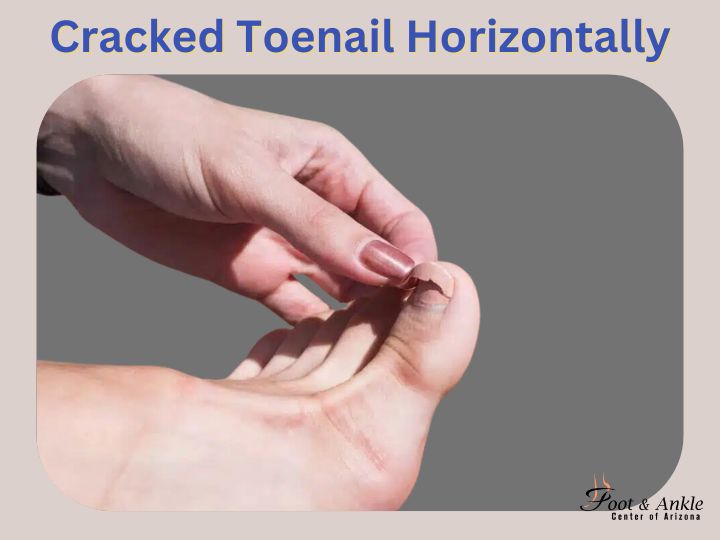Horizontally, a broken toenail can be both painful and related. Whether it is a smaller division or a deep crack, reasons, alternatives and prevention techniques that reach the nail bed, it is necessary to understand. In this guide, we must learn about toenails horizontally critically cracked and effectively restore nail health.
What is a horizontally grated toenail?
A horizontally grated toenail refers to a nail that is divided into width. It differs from a vertical crack, which moves from the nail strap to the tip of the nail. Horizontal cracks can vary in severity, from superficial division to deep fractures affecting the nail bed.
Common Causes of a Cracked Toenail Horizontally
Several factors contribute to cracked toenails, including:
1. Shock or injury
- Against furniture, stabilization of toe or leaving a heavy object can cause a toenail to crack horizontally.
- Repeated pressure from tight shoes or high effects such as running can lead to nail fractures over time.
2. Mushroom infection
- The toe mushrooms can weaken the nail structure, which means that it is divided and broken at risk.
- Mushroom infection often causes nail cord, thickness and brittle.
3. Nutrition deficiencies
- Lack of essential nutrients such as biotin, iron and zinc can weaken nails and cause cracks.
- A balanced diet with sufficient vitamins and minerals supports strong and healthy nails.
4. Excessive moisture risk
- Frequent contacts for water and chemicals can soften the nails, increasing the risk of horizontal cracks.
- Athletes and individuals who often wash their hands and feet are more vulnerable.
5. Underlying health condition
- Conditions such as psoriasis, diabetes and thyroid disorders can affect nail health.
- Autoimmune diseases can also contribute to brittle and slightly cracked nails.
Symptoms of a Toenail Cracked Horizontally
Horizontally, a torn toenail may be present with the following symptoms:
- Over the nail appears
- Nail deviation (yellow, white, or brown backs)
- Uneven
- Signs of increased sensitivity or infection such as redness and swelling
If you notice any of these symptoms that deteriorate, it is recommended to seek a doctor. Dr. Kris A. DiNucci Arizona’s Feet and Ankle’s Center specializes in the treatment of nails and leg conditions.
Treatment Options for a Cracked Toenail Horizontally
Treatment for a horizontally broken sacrament depends on the severity of the crack. Here are some effective solutions:
Home Medications for light cracks
For minor cracks, home nursing can help prevent further damage:
- Trim and file nails: Slow archives coarse edges to prevent snagging.
- Use nails Strong: Use biotin-rich nail styles to improve flexibility.
- Keep the nails dry: Avoid exposure to water for a long time and use respiratory shoes.
- Use mushroom-related cream: If a fungal infection is suspected, fungicide treatment can help.
Medical treatment for serious cracks
If the crack is deep or painful, professional treatment may be required:
- A doctor can use a splint to stabilize the nail when healing.
- Partial nail removal: If the crack extends into the nail bed, partial removal may be required.
- Laser treatment for fungal infection: If a fungal infection weakens the nail, laser treatment is recommended.
How to Prevent a Cracked Toenail Horizontally
Preventing horizontally broken toenails involves maintaining the right leg and nail care. Follow these tips to reduce the risk:
1. Use appropriate shoes
- Choose shoes with enough tear room to reduce the pressure on nails.
- Avoid tight or restrictive shoes that can cause trauma.
2. Keep nails cleanliness
- Trim toenails directly to prevent different voltages on the nail plate.
- Avoid cutting the nails too low, which can weaken the nail structure.
3. Strengthen your nails with nutrition
- Include foods rich in biotin, vitamin E and omega-3 fatty acids for strong nails.
- Stay hydrated to prevent nails from getting brittle.
4. Protect nails from damage
- Wear protective shoes in an environment where foot injuries are common (eg gym, features).
- Use moisture-resistant socks to prevent excessive water absorption.
5. Treat the underlying health conditions
- If you have conditions such as diabetes or psoriasis, you can handle them properly cause nail damage.
- Regular check with a podiatrist can help monitor and maintain nail health.
For more guidance on legs and nail care, check our wide foot care services for specialist treatment options.
When are you going to see a podiatrist for a torn toenail?
While smaller nail cracks can often be cured with proper care, in some cases there is professional attention. Contact a podiatrist if:
- Crack is deep and painful
- The nail is infected (redness, swelling, pus formation)
- Constant malaise or nail-thick
- You have an inherent condition such as diabetes, which increases the risk of complications
Dr. Kris A. DiNucci, D.P.M., F.A.C.F.A.S specializes in the treatment of nail injuries and conditions in the middle of the bone and Arizona. Plan a consultation to obtain expert care that fits your requirements.
Conclusion
Horizontally, a broken toenail can be inherent in trauma, infections or health conditions. While smaller cracks can be cured with home nursing, severe cases may require professional intervention. Preventive measures, such as the right shoes, nail hygiene, and a nutritious diet, can significantly reduce the risk of torn toenails.




